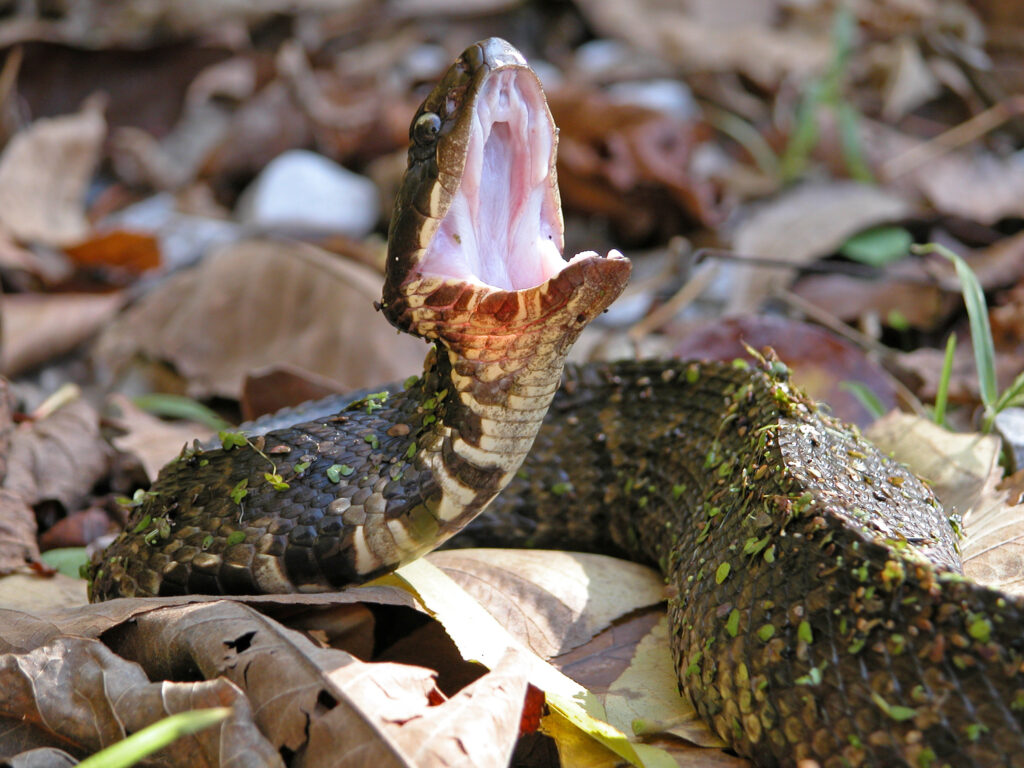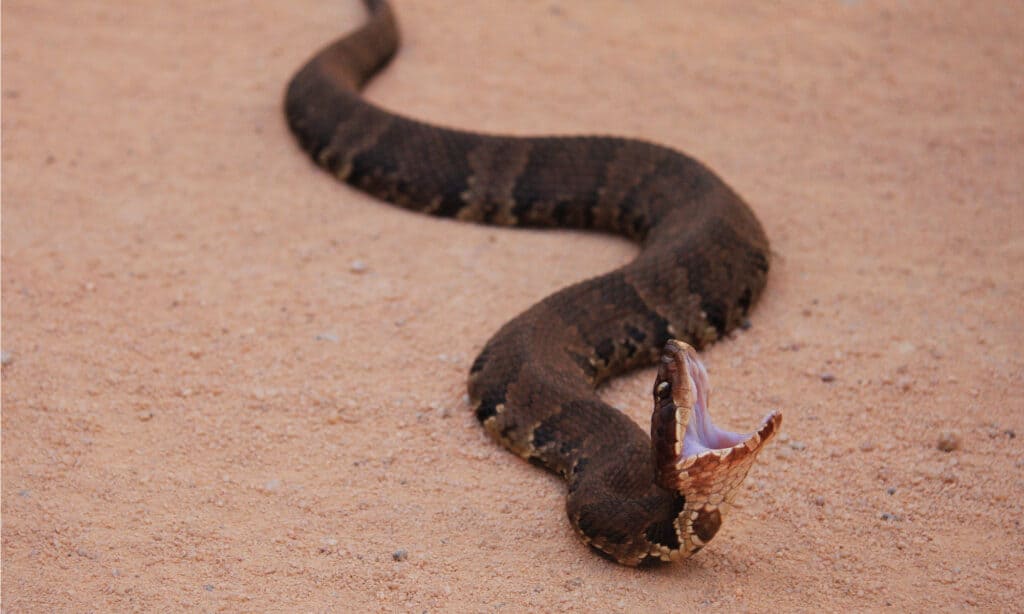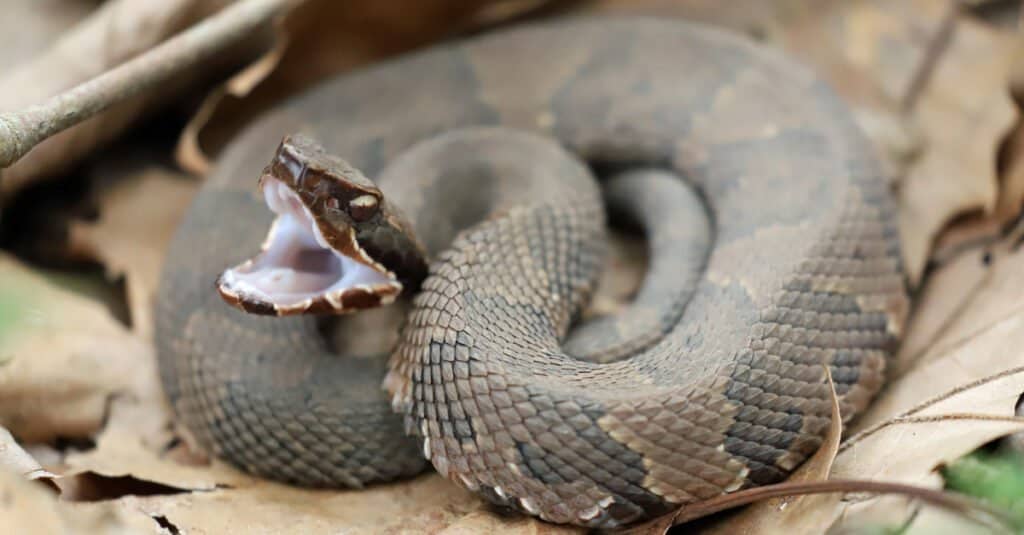During warmer weather, you’re more likely to see species that you didn’t get a chance to see during the winter months. This includes snakes, such as Mississippi cottonmouths. However, while it’s more common to see reptiles during the spring and summer, when exactly do they come out? And when are they most active? Knowing the answers to these questions can help you discover when Mississippi cottonmouths are most common.
Ready to learn more? Let’s jump right in.
About Cottonmouths
“Cottonmouth” isn’t the only name for these snakes. Having the scientific name of Agkistrodon piscivorus, you may also know cottonmouths by the name of water moccasins. Both of these names refer to the same species of snake, and both their common names and scientific names can teach you a lot about when and where to expect cottonmouths in Mississippi to come out.
Their genus name, “Agkistrodon,” is actually a word derived from Greek. Its origin is “ankistron.” This is typically interpreted as a reference to their fangs. Unlike other types of snakes and reptiles, cottonmouths and other snakes in this genus have hooked fangs. However, it can also pair with their species name, “piscivorous,” to refer to their diet. Cottonmouths are fish eaters. They’ll eat other animals, too, such as rodents, birds, and amphibians, but small fish are one of their main sources of nutrition, as will be discussed further below.
Between knowing a bit about their diet and taking into account the common name water moccasin, you’re actually able to learn a lot about the cottonmouth. They favor aquatic environments, which are plentiful in the state of Mississippi. Because they are such a common species of snake here, it’s important to learn more about when they come out and how to identify one during their active periods!

The cottonmouth is in the subfamily
Crotalinae, commonly known as pit vipers.
©iStock.com/Gerald DeBoer
Appearance
Above, you learned just how important and meaningful a name can be when it comes to animals. That’s why, when it comes to this species of snake, the common name “cottonmouth” also has a lot of meaning.
At first glance of a cottonmouth, you might not be able to identify it quickly. Overall, they’re fairly average-looking snakes, without any of the flashy or tell-tale characteristics of other species, such as rattlesnakes. On their back, which is known as their dorsal side, they sport a dark reddish color. Here you’ll find brown and black markings. Since these markings often lack defined, easy-to-distinguish shapes like the diamondback’s clear diamond pattern, you may not recognize it at first. They grow to be of average size, although they’re a little bit longer than many snakes around your home. Adults grow to be around 2 to 4 feet long, with the largest being recorded at around 6 feet long.
While they may not seem unique at a glance, that isn’t entirely true. In fact, there is one key characteristic of the cottonmouth’s appearance. Hint: it’s in their name!
The cottonmouth’s hooked fangs aren’t the only thing interesting about this species. The inside of their mouth is completely white rather than pink or red, which is where their common name comes from. This can be one of the best ways to identify cottonmouths, although you should be careful to keep your distance!
Diet
Learning more about the cottonmouth’s diet is a key part of learning more about when and where they can be seen at. After all, snakes and most other predators won’t often choose to live far from their food source. And, if they’re active hunters, they’ll also tend to sleep on the same schedule as their prey in order to catch them. That’s why it’s significant to learn what Mississippi cottonmouths eat.
Thanks to their scientific and common names, you learned above that cottonmouths like to eat fish and other aquatic animals. This includes frogs, toads, turtles, and even smaller snakes. Sometimes, they’ll also eat mice, lizards, and small birds.
If you live in areas where these animals can be found in abundance, such as near rivers, lakes, or ponds, you have a better chance of encountering a cottonmouth than you do in areas where prey is scarce.
Where to find Mississippi Cottonmouths
For the most part, you can find Mississippi cottonmouths anywhere you can find water. They’re a semi-aquatic species, meaning everything from hunting to raising their offspring is done near the water.
However, it’s important to note that you won’t find cottonmouths in salt water or on the beach. Instead, they prefer freshwater, especially swamps and similar areas that are dark and dense with vegetation. These secretive areas are preferred.

You can find cottonmouth snakes in Mississippi around bodies of water.
©Nathan A Shepard/Shutterstock.com
When Are Mississippi Cottonmouths Active?
Like other species of reptiles, Mississippi cottonmouths are known as ectotherms. You may have commonly heard this term referred to as cold-blooded. This means that snakes are incapable of producing and regulating their own body heat like humans and other mammals can. Instead, they have to gain heat from external sources, such as the sun.
Because of this, cottonmouths favor warmer weather with plenty of sunshine. It’s most common to see cottonmouths begin to come out in the spring months when the average temperature begins to increase. They may be less active in summer due to extreme heat, but you can still find them in shady areas or submerged in the water. Overall, the most common time of year to see cottonmouths out and about is between March and May.
The cottonmouth is also a nocturnal species of snake. Even though they don’t tend to sleep their days away and can still be seen in the sunlight, they’re most active at night. This means this is the time they’re most likely to be seen on the move and hunting.
Are Mississippi Cottonmouths Dangerous?
All wild animals have the potential to be dangerous. However, it is important to pay extra caution when you see a cottonmouth than other types of snakes. This is because the cottonmouth is a venomous species of snake. If they bite you, they can inject venom that can affect your central nervous system and even be deadly without prompt and appropriate treatment.
What to Do if You See a Cottonmouth
If you’re visiting their habitat during warmer weather, you’ll likely come across at least one Mississippi cottonmouth. However, what should you do in this instance?
First, keep your distance. Don’t approach the snake, and don’t try to handle it or move it. Cottonmouths don’t see us as threats unless we make advances toward them. They don’t see us as prey either. As a result, they’ll simply try to escape if they see you. Sometimes, they may come straight toward you and seem like they’re chasing you. This is not the case. Instead, they’re trying to leave and just happen to be going in that direction. Simply step to the side and give plenty of clearance to allow the snake to pass.
Almost no snake bite happens for no reason. Most snake bites occur as a result of handling. Therefore, like with all wild animals, be respectful of Mississippi cottonmouths and honor the space they need. This can keep both you and these fascinating snakes safe.

Mississippi cottonmouths are venomous and can be deadly if a bite isn’t treated quickly.
©KF2017/Shutterstock.com
Venomous Snake Bites: What to Do if A Mississippi Cottonmouth Bites You
Sometimes, however, a bite may occur. Any venomous snake bite is regarded as a medical emergency and needs to be treated as one. This means that if you happen to be bitten by a cottonmouth, you’ll need to seek medical assistance as soon as possible.
Do not apply pressure or try to suck out the venom if you are bitten by a snake. Contact your local emergency services to seek help and receive further instructions on how to care for your bite. Thankfully, with today’s technology, snake bites are rarely lethal. However, this is only because of modern healthcare’s ability to reverse the negative side effects within a certain time period.
The photo featured at the top of this post is © iStock.com/Chase D'animulls
Discover the "Monster" Snake 5X Bigger than an Anaconda
Every day A-Z Animals sends out some of the most incredible facts in the world from our free newsletter. Want to discover the 10 most beautiful snakes in the world, a "snake island" where you're never more than 3 feet from danger, or a "monster" snake 5X larger than an anaconda? Then sign up right now and you'll start receiving our daily newsletter absolutely free.
Thank you for reading! Have some feedback for us? Contact the AZ Animals editorial team.







